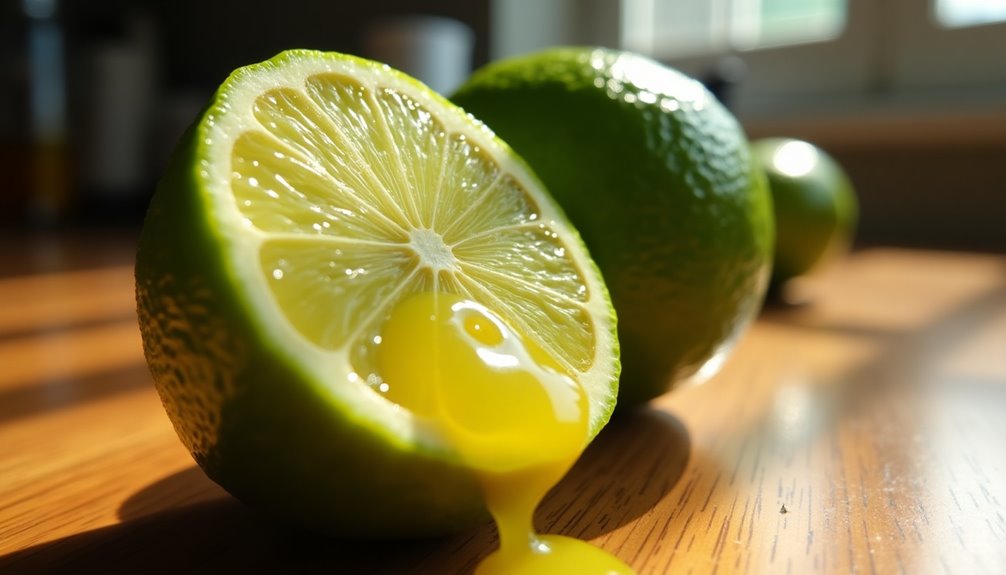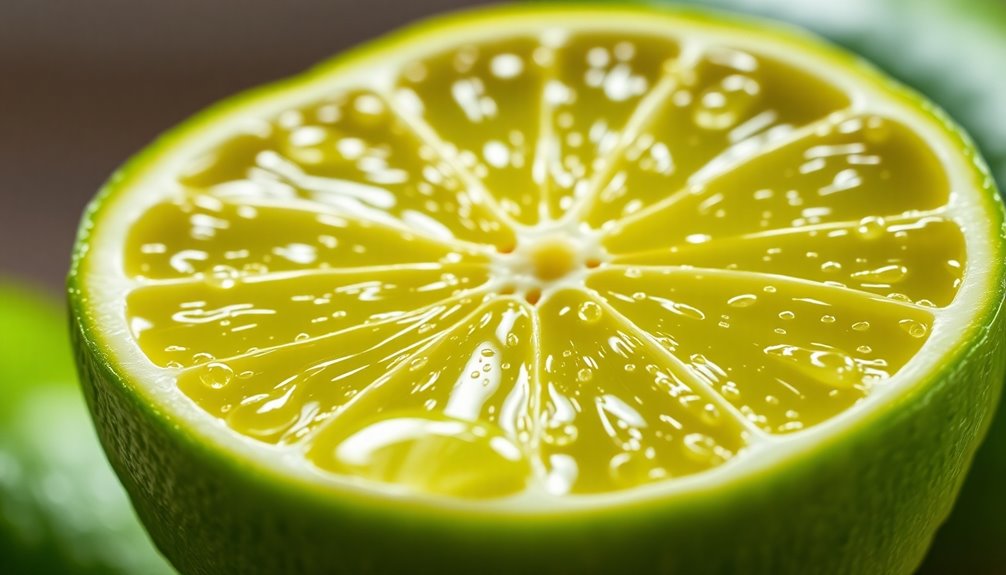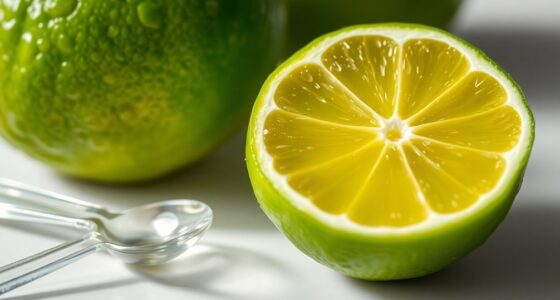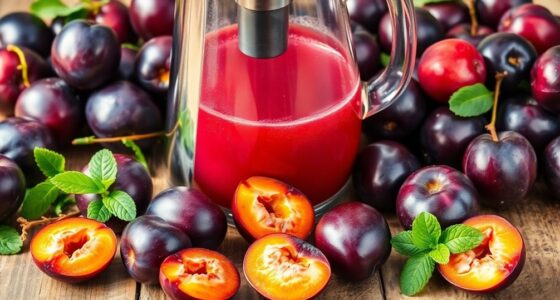A medium lime typically gives you about 2 tablespoons, or 1 ounce, of juice. If you're using larger limes, you might only need one to achieve that amount. Keep in mind that the yield can vary depending on the size and ripeness of the lime. Fresh lime juice offers a vibrant flavor that enhances your dishes, making it an essential ingredient in many recipes. You'll discover even more tips for selecting and using limes next!
Key Takeaways
- A medium lime typically yields about 2 tablespoons (1 ounce) of juice.
- Each half of a lime generally provides approximately 1 ounce of juice.
- For 1/4 cup of lime juice, about 2 medium limes are needed.
- Larger limes may produce enough juice with just one lime.
- Lime juice yield can vary based on the size and ripeness of the lime.

When you grab a medium lime, you can expect to get about 2 tablespoons, or 1 ounce, of juice from it. This yield is perfect for many culinary uses, making limes a staple in kitchens around the world. Whether you're whipping up a zesty dressing, a refreshing cocktail, or a tangy marinade, knowing how much juice you can extract from a lime is essential for your recipes.
If you're planning to make a dish that requires 1/4 cup of lime juice, you'll need approximately 2 medium limes. This amount ensures that you have enough fresh lime juice to achieve that bright flavor that elevates any meal. It's amazing how a simple squeeze of lime can transform a bland dish into something vibrant and exciting.
When you cut a lime in half, you'll generally find that each half provides about 1 ounce of juice, which is typically enough for most culinary applications, from sweet to savory.
One of the reasons many cooks prefer fresh lime juice over bottled lime juice is the difference in flavor. Fresh lime juice has a distinct brightness that bottled varieties can't quite replicate. Bottled lime juice, while convenient, often lacks the fresh, zesty quality that comes with squeezing your own limes. If you've ever tasted a dish made with fresh lime juice, you know exactly what we mean—the difference is palpable.
Lime yields can vary slightly depending on the lime's size and ripeness, but on average, you can rely on a medium lime to give you a consistent amount of juice. Keep this in mind when you're shopping for limes. If you find smaller or larger limes, adjust your quantities accordingly. For instance, if you pick up a particularly large lime, you might only need one to reach that 1 ounce of juice.
Incorporating lime juice into your recipes can enhance flavors in numerous ways. It's not just about the acidity; it's about balancing sweetness and savoriness. Lime juice works wonders in marinades for meats, bringing a fresh zing that tenderizes while adding depth.
In desserts, a splash of lime juice can brighten flavors, taking your sweet treats from ordinary to extraordinary.
Frequently Asked Questions
How Much Juice Is in 1 Lime?
When you squeeze a medium lime, you'll typically get about 2 tablespoons of juice, which is roughly 1 ounce.
If you're planning to use lime juice in a recipe, remember that this can vary based on the lime's size and ripeness.
For a quick reference, half a lime usually yields around 1 tablespoon.
Freshly squeezed juice offers a much brighter flavor than bottled, so it's worth the effort!
Can I Use Bottled Lime Juice Instead of Fresh?
Sure, if you want to swap fresh lime juice for bottled, go ahead!
Just know you're inviting a flat, uninspired taste to your dish. It's like choosing a knockoff designer bag—sure, it looks similar, but it just doesn't have that flair!
If you're in a pinch, use about 2 tablespoons of bottled juice for each lime.
But if you can grab fresh limes, your taste buds will thank you for it!
How Much Real Lime Equals 1 Lime?
When you're wondering how much real lime equals one lime, it's good to know that one medium Persian lime typically yields about 2 tablespoons of juice.
So, if a recipe calls for a specific amount, you can easily estimate how many limes to buy. For instance, if you need 1/4 cup of juice, grab about 2 medium limes for that fresh flavor.
Just keep in mind that Key limes yield less juice!
How Much Concentrated Lime Juice Equals 1 Lime?
To replace the juice of one lime, you'll need about 1 ounce of concentrated lime juice.
Since concentrated juice can be more intense, start with a smaller amount, such as 1 tablespoon, which is roughly equal to half a medium lime.
Taste as you go to ensure the flavor meets your expectations.
Keep in mind that concentrated juice may contain preservatives, which can affect the overall taste of your dish.
Conclusion
In conclusion, a medium lime typically yields about 1 to 2 tablespoons of juice. So, next time you're whipping up a zesty guacamole or a refreshing cocktail, remember that just one lime can pack a flavorful punch! Imagine making a batch of margaritas for friends and realizing you only need two limes to get the perfect tangy taste—everyone will be impressed with your mixology skills! Keep this in mind, and you'll always have the right amount on hand.
Cindy thoroughly researches juicing trends, techniques, and recipes to provide readers with practical advice and inspiration. Her writing style is accessible, engaging, and designed to make complex concepts easy to understand. Cindy’s dedication to promoting the advantages of juicing shines through her work, empowering readers to make positive changes in their lives through the simple act of juicing.

















